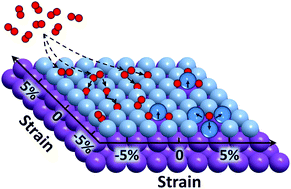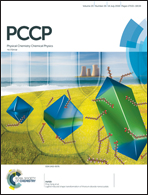Dissociative adsorption of O2 on strained Pt(111)†
Abstract
The adsorption and dissociation of O2 and the adsorption of O* adatoms over strained Pt(111) surfaces have been systematically studied using density functional theory calculations. When the applied bilateral strain ranges from compressive (−5%) to tensile (5%), the adsorption strengths of O and O2 at various sites can be varied substantially by 0.3 to 0.9 eV. Moreover, the preferred adsorption site of O2 also changes from tbt to tfb when tensile strain is larger than 3%. The activation barrier of O2 dissociation can be significantly varied by nearly 0.4 eV from −3% to 3% strain. Meanwhile, the combination of O* adatoms and the applied strain can pull the Pt atom out of the surface and result in dramatic surface buckling. The z direction shift of a Pt atom sandwiched by two fcc O* adatoms is over 0.45 Å when compressive strain goes beyond −2%. The abnormal non-linear responses of O adsorption strength and the lateral O–O interaction to strain all arise from the up-buckled Pt atom. We show that strain is a very powerful tool for tuning the thermodynamic and kinetic properties of oxygen adsorption, dissociation and surface bucking of metal surfaces, which are crucial for understanding the catalytic properties and initial oxidation of transition metal based catalysts.



 Please wait while we load your content...
Please wait while we load your content...